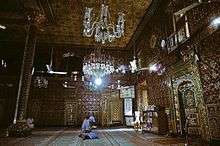Kashmiri Muslims
Kashmiri Muslims are ethnic Kashmiris who practice Islam. The majority of Kashmiri Muslims in the Valley are Sunni.[1] They refer to themselves as "Kashur" in their mother language. Presently the Kashmiri Muslim population is predominantly found in Kashmir valley along with a significant population of Kashmiris in the Chenab valley region, which comprises the Doda, Ramban and Kishtwar districts of Jammu. There are also ethnic Kashmiri populations inhabiting Neelam Valley and Leepa Valley of Azad Kashmir. Since 1947, many ethnic Kashmiri Muslims also live in Pakistan.[2] Smaller Kashmiri communities also live in other regions of the Jammu and Kashmir state. Kashmiri language, or Kashur, belongs to the Dardic group and is the most widely spoken dardic language.[3][4]

History
Buddhism, Hinduism and Animistic type religions had been prevalent in Kashmir at various points of time. Islam started making inroads in the 12th and 13th centuries. The earliest copy of Quran in Kashmir dates back to 1237 AD and was calligraphed by Fateh Ullah Kashmiri who is believed to be a then Kashmiri Islamic scholar.[5] The first Muslim missionary in Kashmir was Syed Sharaf-ud-Din Abdur Rahman Suhrawardi popularly known as Bulbul Shah to common masses. He was an extensively travelled preacher and came to Kashmir during the reign of Raja Suhadeva (1301–20). Impressed by Bulbul Shah's simplicity and noble character, King Rinchan Shah the ruler of Kashmir accepted Islam and came to be known as Sultan Saddrudin Shah. He was the first Muslim ruler of Kashmir. Following Rinchan's conversion his brother-in-law who was the army commander in chief also became Muslim. In 1339 Kashmir throne was captured by Sultan Shahmir who founded Shahmiri dynasty in Kashmir. Subsequently according to some traditions ten thousand Kashmiris adopted Islam and hence the seeds of Islam in Kashmir were sown. The spread of Islam among Kashmiris was further boosted by arrival of a host of other Sayyids, most prominent among them being Sayyid Jalal-ud-Din, Sayyid Taj-ud-Din and Sayyid Hussain Simanani.[6] However the greatest missionary whose personality wielded the most extraordinary influence in the spread of Islam in Kashmir was Mir Sayyid Ali Hamadani of Hamadan (Persia) popularly known as Shah-i-Hamadan. He belonged to the Kubrawi order of Sufis and came to Kashmir along with seven hundred disciples and helpers. His emphasis was on the Islamization of royal family and the court as a pre-requisite for Islamizing people. This was an important modus operandi adopted by Syed Ali and his deciples. He was of the firm belief that the common masses followed the conduct and culture of their rulers. His disciples established shrines with lodging and langar at many places in Kashmir which served as centres for propagation of Islam. His preaching resulted in a colossal number of Kashmiri people and priests of the aforementioned religions along with thousands of their followers converting to Islam which became the vastly dominant religion of the Kashmiri masses by the fourteenth century. Mir Sayyid Ali Hamadani's impact in Kashmir was not only confined to religion but had a great say on culture, industry and economy of Kashmir. Spread of shawl making, carpet manufacturing, cloth weaving, etc. gained great prominence by his efforts.[7][8]
Dogra Regime
The 100 year Dogra regime turned out to be a disaster for the Muslim peasantry of Kashmir Valley.[9] Walter Lawrence described the conditions of the Valley's peasantry as being 'desperate' and noted that the Valley's peasantry attributed their miseries to the Maharajah's deputies rather than the rulers themselves. The state officials apparently kept the rulers from knowing the conditions of the Muslim peasantry in the Valley.[9] Lawrence in particular criticised the state officials who belonged to the Kashmiri Pandit community. [9]
Gawasha Nath Kaul described the poor conditions of the Valley's Muslim population in his book Kashmir Then And Now and in it he wrote that 90 percent of Muslim households were mortgaged to Hindu moneylenders.[10] Muslims were non-existent in the State's civil administration and were barred from officer positions in the military.[10]
Prem Nath Bazaz, one of the few Kashmiri Pandits who joined the movement for change, described the poor conditions of the Valley's Muslim population as such:[10]
The poverty of the Muslim masses is appalling. Dressed in rags and barefoot, a Muslim peasant presents the appearance of a starved beggar...Most are landless laborers, working as serfs for absentee landlords.
A large number of Muslim Kashmiris migrated from the Kashmir Valley[10] to the Punjab in the late 19th century because they faced natural disasters and oppression by the Dogra Hindu rulers of Kashmir.[11] According to the 1911 Census there were 177,549 Kashmiri Muslims in the Punjab. With the inclusion of Kashmiri settlements in NWFP this figure rose to 206,180.[12] Common Kashmiri krams (surnames) found amongst the Kashmiris in Kashmir Valley and amongst the Kashmiri emigres in Punjab include Butt/Bhat, Dar, Lone, Wani/Wain, Mir and Shaikh.[13]
References
- ↑ Snedden, Christopher (2015). Understanding Kashmir and Kashmiris. Oxford University Press. p. 7. ISBN 9781849046220.
As in Pakistan, Sunni Muslims comprise the majority population of Kashmir, whereas they are a minority in Jammu, while almost all Muslims in Ladakh are Shias.
- ↑ Snedden, Christopher (2015). Understanding Kashmir and Kashmiris. Oxford University Press. ISBN 9781849046220.
- ↑ "Introduction".
- ↑ "Introduction".
- ↑ "History".
- ↑ "History".
- ↑ "History".
- ↑ "History".
- 1 2 3 Bose, Sumantra (2013). Transforming India. Harvard University Press. ISBN 9780674728202.
- 1 2 3 4 Bose, Sumantra (2013). Transforming India. Harvard University Press. ISBN 9780674728202.
- ↑ Bahl, Arvin (2007). From Jinnah to Jihad: Pakistan's Kashmir Quest and the Limits of Realism. Atlantic Publishers & Dist. p. 76. ISBN 9788126907212.
- ↑ Jalal, Ayesha (2002). Self and Sovereignty: Individual and Community in South Asian Islam Since 1850. Routledge. p. 352. ISBN 9781134599387.
- ↑ A Glossary of the Tribes and Castes of the Punjab and North-West Frontier Province. Nirmal Publishers and Distributors. Retrieved 25 March 2007.